“I believe with my whole heart that God is far from being done with using us to help build and live God’s dream for the world.”
—Shannon J. Kershner, February 14, 2021
With plans for a new building complete and John Buchanan’s retirement imminent, the demolition of Westminster House began in the first half of 2011, with the official groundbreaking for the new building taking place in June. This temporary loss of space necessitated adaptations from the numerous programs that used Westminster House—with Sunday School taking place behind dividers in Anderson Hall, the Social Service Center taking up residence in a trailer, the Day School operating from the Manse, and a great deal of the church’s offices and programming moving to the 737 North Michigan office building two blocks south of the church. In retrospect, it was fitting that the church’s 4:00 p.m. worship service had transformed into a jazz service the prior summer—a precursor of the ways the congregation would improvise and adjust during the simultaneous transitions of space and leadership.
On January 29, 2012, John Buchanan preached his final sermon as Fourth Church’s pastor, stating near the conclusion, “So we come to an end and a new beginning for this great church and its people. ... And we look forward to what lies ahead, for you and for us, with great confidence and hope and hearts full—overflowing—with gratitude.”
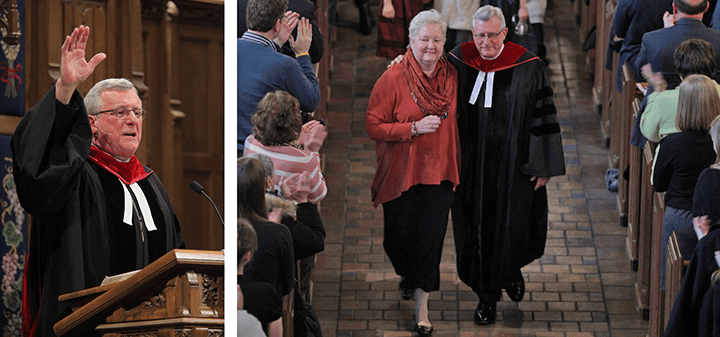
On January 29, 2012, John Buchanan served his last Sunday as pastor of Fourth Church, delivering a final benediction (left) before recessing out the center aisle with wife Sue.
Following Buchanan’s retirement, Calum MacLeod took over as acting Head of Staff while the Pastor Nominating Committee began a nationwide search process. The “transition years” that followed certainly held numerous challenges, but there was indeed a sense of opportunity and excitement when the Gratz Center opened for programming in November 2012, less than a year and a half after breaking ground on the project. All five floors were soon filled with a wide array of programming, including the newly dedicated Buchanan Chapel on the second floor.

After several smaller buildings had been cleared away, in September 2011 the new Gratz Center was underway but not yet above ground. One year later—and exactly 100 years after the laying of the church cornerstone at Michigan and Delaware on September 17, 1912—the cornerstone was laid for the nearly finished Gratz Center on September 16, 2012.
Shortly after the building opened, though, there were more transitions to follow. Pastoral staff who had stayed on to help the church through this season of change soon began to retire or leave for other opportunities over the next two-and-a-half years—all of whom had been serving at Fourth Church since 2006 or earlier: Tom Rook (Parish Associate), Donna Gray (Children and Family Ministry), Calum MacLeod (Executive Associate; Evangelism), Adam Fronczek (Worship and Adult Education), Joyce Shin (Congregational Life), and John Vest (Youth)—along with the tragic passing of John Boyle in 2013, founder of the Replogle Counseling Center as well as a Parish Associate.
In the midst of these departures, though, came a new arrival: Shannon Johnson Kershner was introduced to the congregation as the next Pastor and Head of Staff on March 2, 2014, later preaching her first sermon on the same Sunday as the 100th anniversary of the Sanctuary! Kershner had previously served as Head of Staff at Presbyterian churches in Texas and North Carolina and was renowned both as a preacher and leader within the denomination.
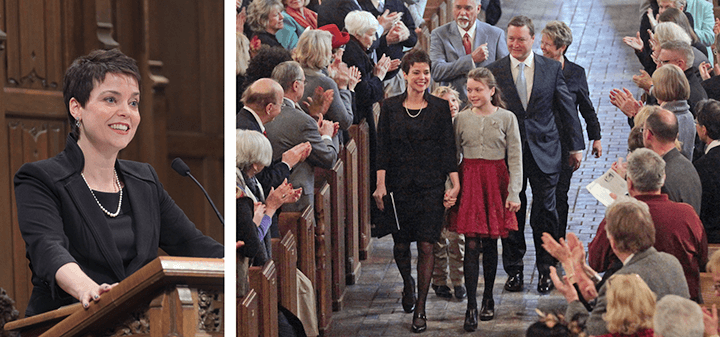
A little more than two years after John Buchanan’s final Sunday as pastor, at a congregational meeting on Sunday, March 2, 2014, the congregation enthusiastically called Shannon Johnson Kershner to serve as its new pastor.
Over her first few years, Kershner helped the church navigate those wider staff transitions, while also encouraging the congregation to build a culture of discipleship through which the church could “practice what we preach.” In 2016, Session laid out an aspiration that “Fourth Presbyterian Church exudes a culture of discipleship in which we can, we do, and we will exude Christ’s love in every aspect of our life”—a statement that would later be built upon through a 2018 strategic listening campaign of hundreds of one-on-one meetings between Session Elders, staff, and church members to discern where God was leading Fourth Church next.
These conversations were ultimately distilled into five strategic directions for the church moving forward, all five of which were formally adopted by the Session in October 2019: Embrace Racial Equity, Partner in Mission and Social Justice, Engage Young Adults, Leverage Technology, and Live in a Spirit of Abundance. The directions were written broadly so individual leaders and programs could wrestle with how they might live into those commitments, particularly in light of an audit done by the church’s Racial Equity Council that highlighted several areas in which the church’s culture and practices needed to change. This pressing need to address systemic issues of inequity was further underscored by the murder of George Floyd the following May, yet one more tragic example of how Black lives are still not treated equally in this country.
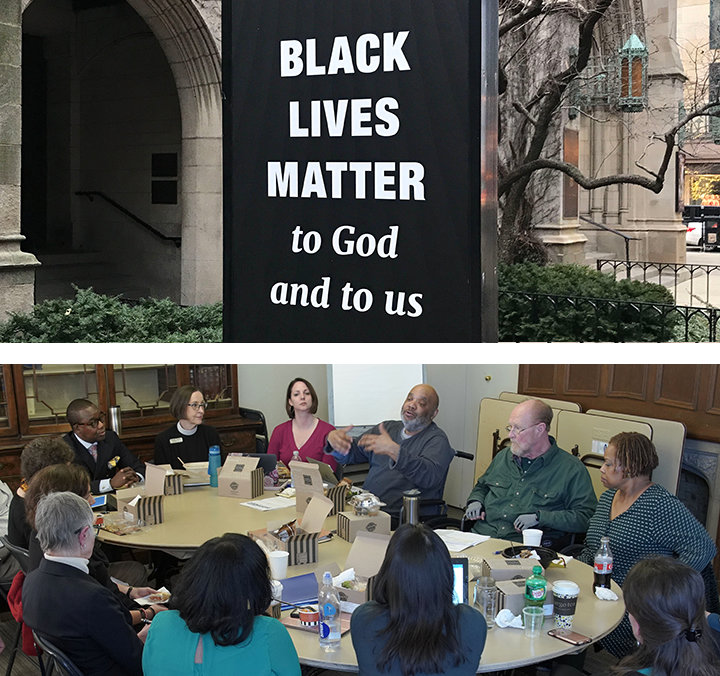
On April 20, 2018, the Racial Equity Council became a standing council of the Fourth Presbyterian Church Session to serve as a catalyst in the intentional pursuit of racial equity. The congregational commitment to purposely include all people, strive for radical hospitality, and model an antiracist approach in all areas shapes not only public witness but also transformative small group conversations, education classes, public forums, and community engagement.
On March 12, 2020, a decision was made to suspend in-person worship services that upcoming Sunday due to the rapidly accelerating COVID-19 pandemic, and for the first time in the church’s history, Sunday worship was done entirely online. A statewide stay-at-home order soon meant that Kershner had to livestream worship from the living room of the Walton Manse—a property the church had purchased just a year prior—before eventually shifting back to livestreaming from the Sanctuary space. Like many places, Fourth Church’s programming slowed significantly in those first handful of months, although the vital work of the Chicago Lights Social Service Center and Fourth Church Meals Ministry programs continued even in the early days of the pandemic as the church tried to support the vulnerable in a time of crisis.
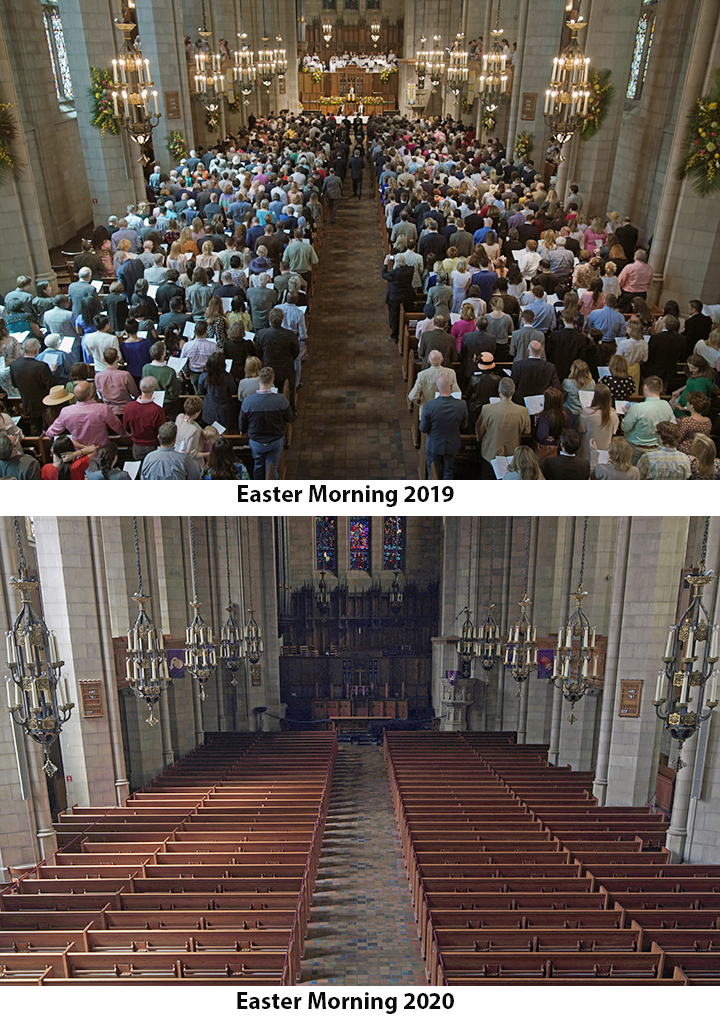
Due to the onset of the COVID pandemic in March 2020, for the first time since the Chicago Fire almost 150 years earlier Fourth Church members and visitors were unable to hold Sunday worship in their own Sanctuary. Sunday services immediately moved online (initially streamed from the pastor’s living room and later that spring from the Sanctuary), and it was to be more than a year before in-person worship resumed in June 2021.
What had once seemed like a temporary measure, though, has gone on far longer than anyone (aside from epidemiologists) would have predicted. It would be more than fifteen months until the church could safely hold in-person services back in the Sanctuary again, with most members continuing to worship online today as, almost two years later, the history of the pandemic is unfortunately still being written.
The 150th anniversary celebration year certainly hasn’t looked the way anyone expected it to look. But it is perhaps one more example of the way Fourth Church has lived into the unofficial motto of the Presbyterian church over the years: the Church Reformed, and always reforming. We are indeed reforming after 150 years of life together, by and through and with God’s help.
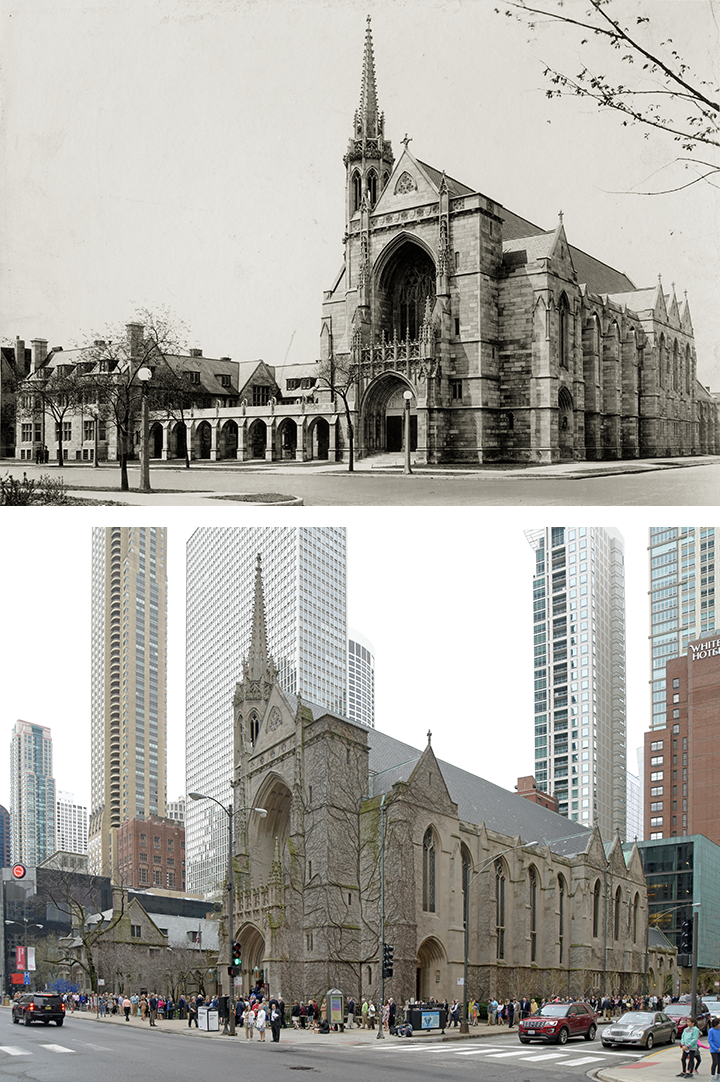
Although the surrounding neighborhood has changed significantly since the Michigan Avenue campus was completed in 1914 (top photo), Fourth Church has weathered innumerable social and cultural storms to ensure that it will remain a light in the city and a beacon of hope for countless people near and far.
• • •
A postscript from author Matt Helms
I’d like to begin by acknowledging my deep gratitude to several people for making these monthly history articles possible. First, I am indebted to the fantastic work of Marilee Munger Scroggs (A Light in the City) and James Wellman (Gold Coast Church and the Ghetto). If these monthly writings have piqued your interest, both books remain the authoritative histories of Fourth Church. Equally vital was Micah Marty, who is not only an extraordinary repository of Fourth Church’s history but also contributed all of the pictures and captions that you’ve seen throughout this series. I am grateful for the editing eye of Jan Feldman and Juli Crabtree, along with editor-in-chief Ann Rehfeldt, for all that they did to improve and clarify these articles. I am appreciative to those who gave of their time in interviews and proofreading—John Buchanan, Morgan Simmons, Don Allerton, and Arlene Faulk among them—to ensure that these articles remained faithful to the people and eras being written about. Lastly, I am grateful to all those who have preserved the church’s history through the archives over the years: Louise Howe and Bob Rasmussen and many others whose names I sadly do not know.
It also feels important to acknowledge that any attempt to cover 150 years of history will invariably involve omissions, oversights, and oversimplifications: 10,000 words later, there is still far more to be shared! One of the primary ways I have been conscious of this throughout the series is the relatively limited mention of church members and the wider staff. The long tenure of Fourth Church’s head pastors may be a convenient way to create easily identifiable “eras” in the church’s history, but this approach obscures the immense contributions of the hundreds, if not thousands, of members and staff who have helped author the history of this congregation over the years. Similarly, major news events and wider societal shifts were often covered in a sentence or two, leaving little room for nuance or further explanation. In both instances, I regret all the stories left untold.
Gratitude and mea culpas aside, I suppose my final reflection on having the privilege of diving into this congregation’s history is that it has been inspiring to see how the church has, again and again, successfully adapted itself through seasons of change and challenge. The church rose from the ashes of the Great Fire, saw the neighborhood around it transform several times over, navigated seismic shifts and events in the wider city and culture, and tried to be a faithful witness to the thousands upon thousands who have come through our doors.
As we all well know, we are once more living through a season of change and challenge. Even at the risk of hyperbole, I feel confident in saying the challenges facing Fourth Church are as daunting as at any point in our history—save the church rebuilding in the wake of the Great Chicago Fire. The pandemic has rapidly accelerated the steady decline in church involvement that has been simmering in our denomination for decades, particularly in the demographic of those under forty. The congregation has been largely distant from one another for almost two years running, and the emotional toll of these past two years of uncertainty, loneliness, and loss cannot be underestimated. We have our work cut out for us as we continue into this unknown future, but if history is any guide, we will meet these new challenges through God’s help.
• • •
<< Back to index of 12 chapters